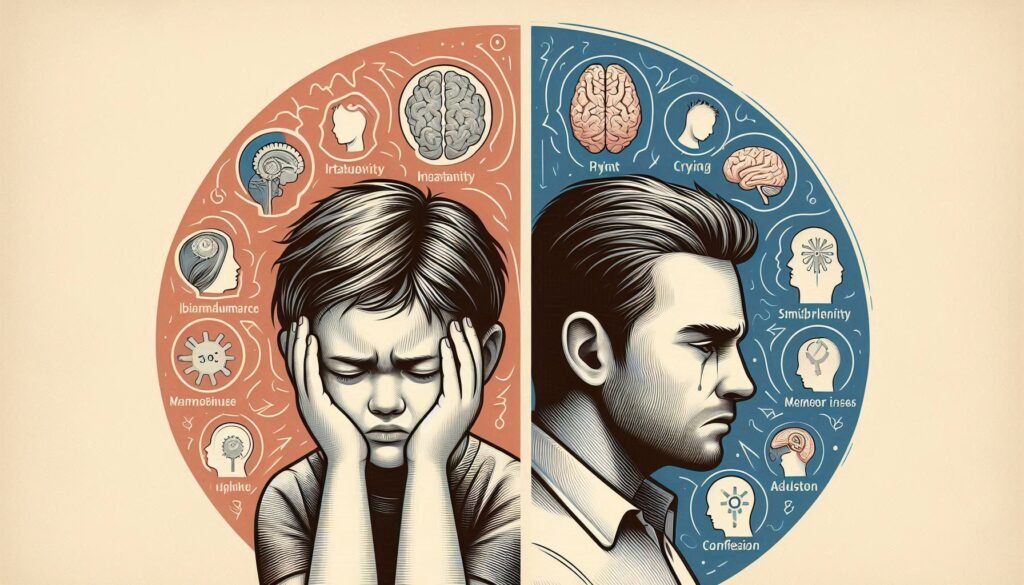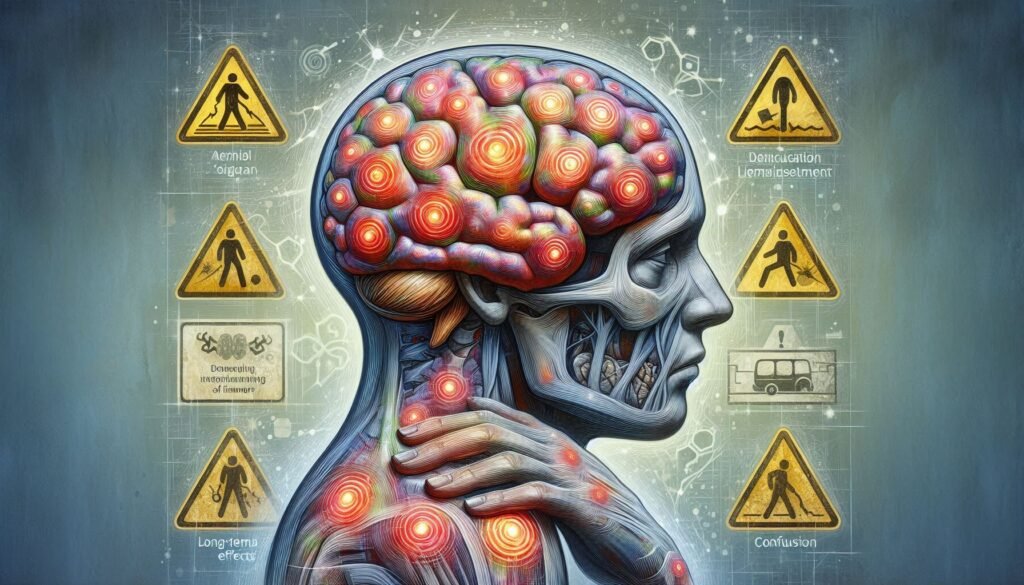Concussions are a hot topic in both sports and healthcare, especially when it comes to our youth. While many people associate concussions with athletes, they can occur during everyday activities like playing at the park or even riding a bike. The symptoms of a concussion may seem similar across age groups, but significant differences exist between children and adults that warrant attention. Understanding these distinctions is crucial for proper identification, management, and recovery.
In this post, we’ll dive into the unique nature of pediatric concussions compared to those experienced by adults. We will explore common symptoms to look out for in both demographics and discuss how factors such as cognitive challenges and emotional responses vary with age. Whether you’re a parent looking to keep your child safe or an adult wanting to know more about your own health risks, this guide aims to provide valuable insights into concussion symptoms in children vs adults. Let’s get started!

Understanding the Unique Nature of Pediatric Concussions
Pediatric concussions present unique challenges due to the ongoing development of a child’s brain. Unlike adults, children’s brains are still maturing, making them more vulnerable to the effects of head injuries. This developmental stage can lead to different concussion symptoms and recovery patterns compared to older individuals.
Children may not be able to articulate their feelings or describe their symptoms accurately. They might struggle with recognizing changes in their behavior or cognitive function after an injury. Thus, parents and caregivers should be vigilant for subtle signs that could indicate a concussion.
Additionally, children’s bodies react differently when injured. Their physical resilience can mask the seriousness of a concussion until significant symptoms arise later on. Understanding this means being proactive about monitoring behaviors and reactions post-injury.
Pediatric concussions often require tailored management strategies that consider both physical and emotional aspects of healing. Recognizing these unique factors is essential for effective intervention and support during recovery.
Common Concussion Symptoms in Children: What to Look For
Identifying concussion symptoms in children can be challenging. Young ones often lack the vocabulary to express their feelings accurately. Parents and caregivers need to be vigilant for subtle signs that may indicate a head injury.
Physical symptoms are commonly observed first. Children might complain of headaches, dizziness, or balance issues after an impact. They could also show sensitivity to light or noise, which may lead them to withdraw from activities they usually enjoy.
Cognitive changes are another key area of concern. Kids might exhibit confusion or difficulty concentrating on tasks like homework or games. Forgetfulness regarding recent events is also a common symptom that should not be overlooked.
Emotional and behavioral shifts can manifest quickly as well. A child who experiences a concussion may become irritable, anxious, or more emotional than usual. Recognizing these variations early is crucial for ensuring proper care and recovery strategies tailored specifically for young brains.
Adult Concussion Symptoms: Typical Presentations
Adults experiencing a concussion often exhibit symptoms that can vary widely in intensity. Headaches are one of the most common complaints, frequently described as pressure or throbbing. These headaches can emerge immediately after an injury or develop over several days.
Dizziness and balance issues are also prevalent among adults with concussions. This may manifest as light-headedness, vertigo, or an unsteady gait, making everyday activities challenging and potentially dangerous. Furthermore, sensitivity to light and noise is not uncommon; bright lights and loud sounds can exacerbate discomfort significantly.
Cognitive impairments often arise post-injury as well. Adults might find it difficult to concentrate or remember details from conversations or tasks they were engaged in before the injury. Fatigue is another typical symptom that affects daily functioning—many report feeling unusually tired even after minimal exertion.
Emotional disturbances such as irritability, anxiety, or depression can surface following a concussion too. These mood changes may be temporary but can complicate recovery if not addressed properly during rehabilitation efforts.
Cognitive and Academic Challenges in Pediatric vs Adult Concussions
Cognitive and academic challenges following a concussion can manifest differently in children compared to adults. In children, the developing brain is more susceptible to disruptions caused by injury. This can lead to significant difficulties in attention, memory retention, and problem-solving skills.
For students, these cognitive impairments often translate into struggles with schoolwork. Children may find it hard to concentrate during lessons or complete assignments that once seemed easy. Their performance can dip dramatically after a concussion, impacting grades and overall confidence.
Adults typically experience cognitive issues as well but may have greater resilience due to fully developed brains. They might face lapses in short-term memory or slower processing speeds but are generally better equipped to manage tasks at work despite their symptoms.
However, the adult workplace environment allows for more flexibility than a classroom setting does. Adults can negotiate responsibilities while they recover; children lack such autonomy and must rely on educators for support during this critical healing phase.
Emotional and Behavioral Changes: Age-Related Differences
Emotional and behavioral changes following a concussion can manifest differently in children compared to adults. Children may display heightened irritability, mood swings, or increased emotional sensitivity. These shifts can stem from their developing brains’ inability to process stress and emotions effectively.
In contrast, adults experiencing similar injuries might exhibit frustration, anxiety, or depression but often have more coping strategies at their disposal. This difference may lead to varied responses when faced with the challenges of recovery.
Furthermore, children are generally less aware of their emotional state. They might struggle to articulate what they’re feeling or why they feel that way. Adults usually possess better insight into their mental health and its fluctuations post-injury.
Recognizing these differences is vital for caregivers and medical professionals alike. Tailored support systems can be established based on age-related needs during recovery for both groups.
Physical Symptoms Comparison Between Children and Adults
Physical symptoms of concussions can manifest differently in children compared to adults. Children often struggle to articulate what they are experiencing, making it challenging for caregivers to identify a concussion. They may exhibit more subtle signs, such as decreased energy or lethargy.
In contrast, adults are generally better at expressing their symptoms. Common physical indicators for both age groups include headaches and dizziness. However, the intensity and type of headache might vary; children may experience a dull ache while adults report throbbing pain.
Nausea and vomiting are also prevalent in both demographics but tend to occur more frequently in younger individuals after an injury. This could be attributed to their developing brains being less resilient than those of adults.
Balance issues can arise too; however, children might show this through clumsiness during play or sports activities. Adults might notice difficulty with coordination during daily tasks or exercise routines, highlighting the need for tailored assessments based on age.
Recovery Timelines: How Age Affects Concussion Healing
Recovery from a concussion varies significantly between children and adults. For children, healing can take longer due to their developing brains. Studies indicate that they may experience prolonged symptoms lasting weeks or even months after the injury.
Adults tend to recover faster, often within a few days to several weeks. Their cognitive functions are typically more established, which allows for quicker recovery of brain function post-injury. However, age-related factors such as previous concussions or health conditions can complicate recovery timelines in both groups.
Additionally, children’s reliance on routine and structure makes them more susceptible to disruptions caused by concussions. Missing school can exacerbate emotional distress and hinder recovery efforts.
Conversely, adults might face work-related pressures that could delay their return to normal activities despite feeling better physically. Age plays a crucial role in determining not just how long it takes to heal but also the overall impact of the concussion on daily life.
Return-to-Learn vs Return-to-Work Protocols
Returning to daily activities after a concussion requires careful consideration, especially for children and adults. The return-to-learn protocol focuses on helping students reintegrate into the academic environment safely. This often involves gradual adjustments in workload, allowing time for breaks and monitoring symptoms closely.
For children, schools may implement accommodations such as modified assignments or extended deadlines. Teachers and parents should collaborate to create an individualized plan that supports recovery while maintaining educational engagement.
In contrast, return-to-work protocols for adults emphasize resuming professional responsibilities without overwhelming stressors. Employers may need to provide flexible work hours or reduced workloads during the initial recovery period.
Both protocols prioritize cognitive rest first before gradually reintroducing typical tasks. Balancing these approaches is crucial since both learning and working environments can be demanding, potentially exacerbating symptoms if not managed properly during recovery stages.
Long-Term Implications of Concussions in Developing Brains
Concussions can have lasting effects, especially on developing brains. Children’s neurological systems are still maturing, which makes them particularly vulnerable to the impacts of traumatic brain injuries. Repeated concussions may disrupt normal brain development and lead to significant cognitive issues.
Studies indicate that childhood concussions can result in long-term memory problems and reduced attention spans. These challenges may affect academic performance and daily functioning as children grow into adulthood. Their ability to process information could be compromised.
Emotional regulation is another concern linked to concussions in younger individuals. Children who experience head trauma may exhibit increased anxiety or mood swings that persist over time. This emotional instability can hinder relationships with peers and family members.
Furthermore, there’s evidence suggesting a correlation between multiple concussions in childhood and an increased risk of neurodegenerative diseases later in life. Understanding these implications highlights the necessity for proper management of concussion symptoms in children versus adults.
Age-Appropriate Management Strategies for Concussion Recovery
Age-appropriate management strategies play a crucial role in the recovery process for both children and adults following a concussion. For children, it’s vital to adopt a gradual approach that takes into account their developing brains. Initially, rest is essential—both physical and cognitive—to allow the brain time to heal. Parents should monitor symptoms closely and limit screen time, homework, or any mentally taxing activities until cleared by a healthcare professional.
For adults, while rest remains important during the initial stages of recovery, returning to work can often happen sooner than with children. It’s key for adult patients to communicate openly with employers about their condition; flexible working hours might ease the transition back into full responsibilities.
Both demographics benefit from tailored rehabilitation programs that include supervised exercise but are adjusted according to age-specific needs. Support systems—be it family involvement for kids or peer support groups for adults—can greatly enhance emotional well-being throughout recovery.
Establishing clear return-to-learn plans for students alongside return-to-work protocols can ensure effective reintegration into everyday life after experiencing concussion symptoms in children vs adults varies significantly but understanding these differences leads to better outcomes across all ages.


